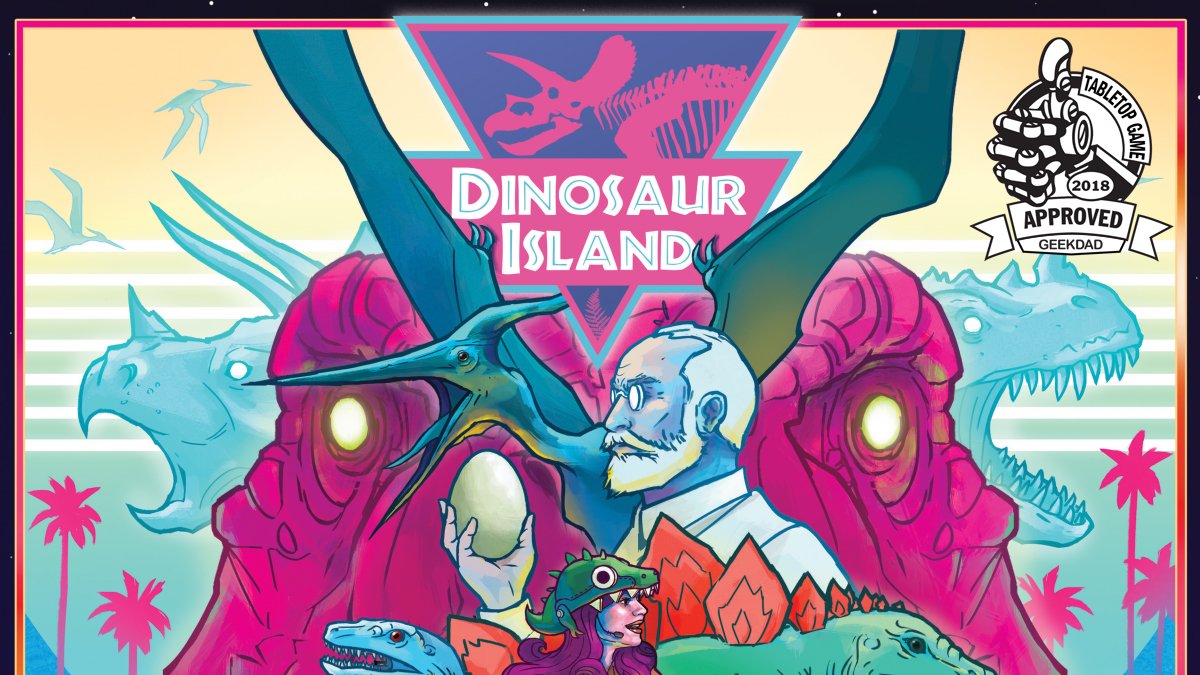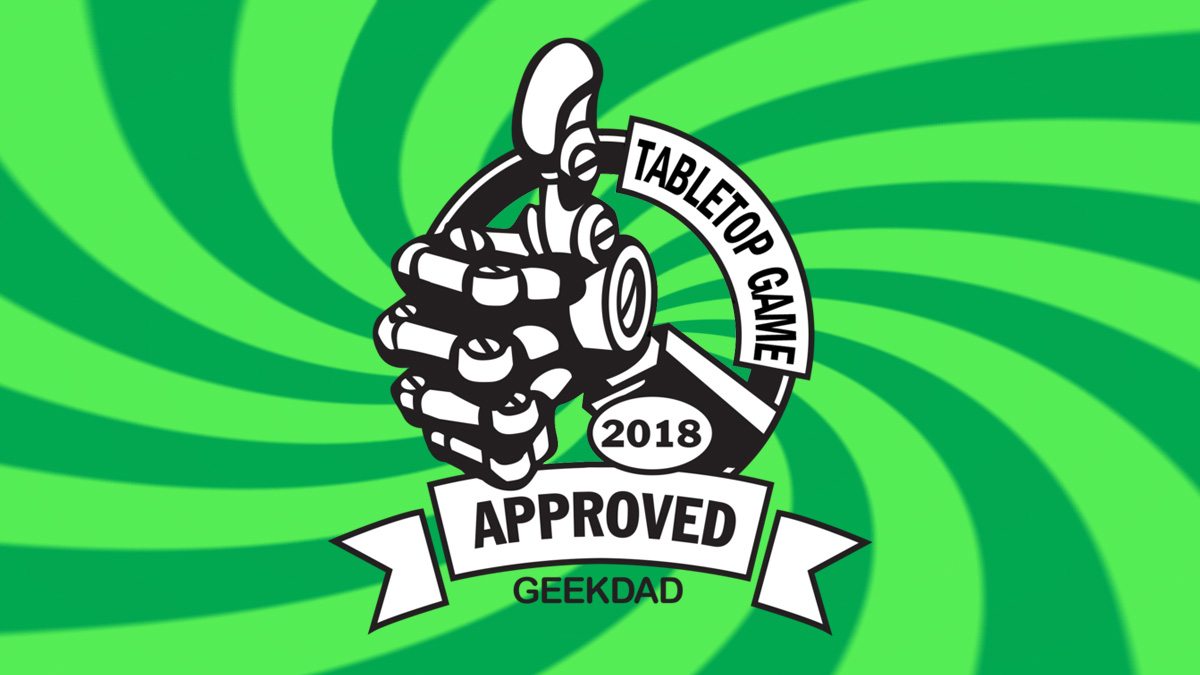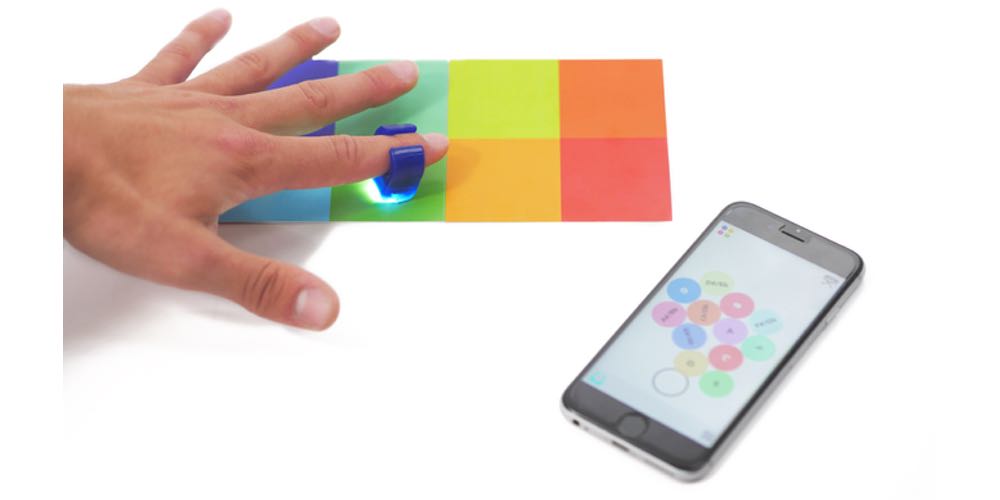 After some initial problems—should I call them T. wrecks?—dinosaur theme parks have significantly improved. Sure, there’s still the occasional escaped dinosaur that eats a patron, but everyone signs the liability waivers when they buy tickets. Make your park the most exciting, tighten up your security, and build the best Dinosaur Island!
After some initial problems—should I call them T. wrecks?—dinosaur theme parks have significantly improved. Sure, there’s still the occasional escaped dinosaur that eats a patron, but everyone signs the liability waivers when they buy tickets. Make your park the most exciting, tighten up your security, and build the best Dinosaur Island!
What Is Dinosaur Island?
Dinosaur Island is a game about building a dino theme park for 1 to 4 players, ages 10 and up, and takes about 60–150 minutes to play. (It has short, medium, and long game modes, so you can adjust the game length independently of player count.) The base game was on Kickstarter last year and quickly sold out of its first print run; Pandasaurus Games is back on Kickstarter now for the Totally Liquid expansion, as well as the 2-player-only Duelosaur Island. You can pledge for the base game at $85, Totally Liquid for $45, and Duelosaur Island for $35 (with some discounts if you’re getting multiple items).
Dinosaur Island is GeekDad Approved!
I didn’t back the original campaign but managed to buy a copy before they were all sold out—though it’s the retail edition, not the fancy Kickstarter edition. This post is a review of the base game only, but you can check out the Kickstarter campaign for more about Totally Liquid and Duelosaur Island.
New to Kickstarter? Check out our crowdfunding primer, and visit our Kickstarter curated page for more projects we love.

Dinosaur Island Components
- Research Center board
- Track board
- Marketplace board
- 4 Lab boards
- 4 Park boards
- 22 Specialist cards
- 39 Objective cards
- 11 Plot Twist cards
- 17 Solo Play cards
- 81 Coins (53 $1, 28 $5)
- 80 Visitors (70 Patrons, 10 Hooligans)
- Cloth bag
- 50 Dinosaurs
- 36 Workers (9 each in 4 player colors)
- 40 Marker cubes (10 each in 4 player colors)
- 12 Scientist tokens (3 each in 4 player colors)
- 24 Corporation tokens (6 each in 4 player colors)
- 24 Limit cubes
- 33 Lab Upgrade tiles
- 30 Attraction tiles
- 29 Paddock tiles
- 17 Dino Recipe tiles
- 12 Modifier tokens
- First Player tile
There are also a few blank tiles for making your own lab upgrades, attractions, and dinosaur recipes. And, adding to the ’90s theme, there are 12 little tokens that just have catchphrases like “Cut. It. Out.” and “Not,” though these aren’t used for anything in the game—they’re just there to use the extra tokens from the die-cut.
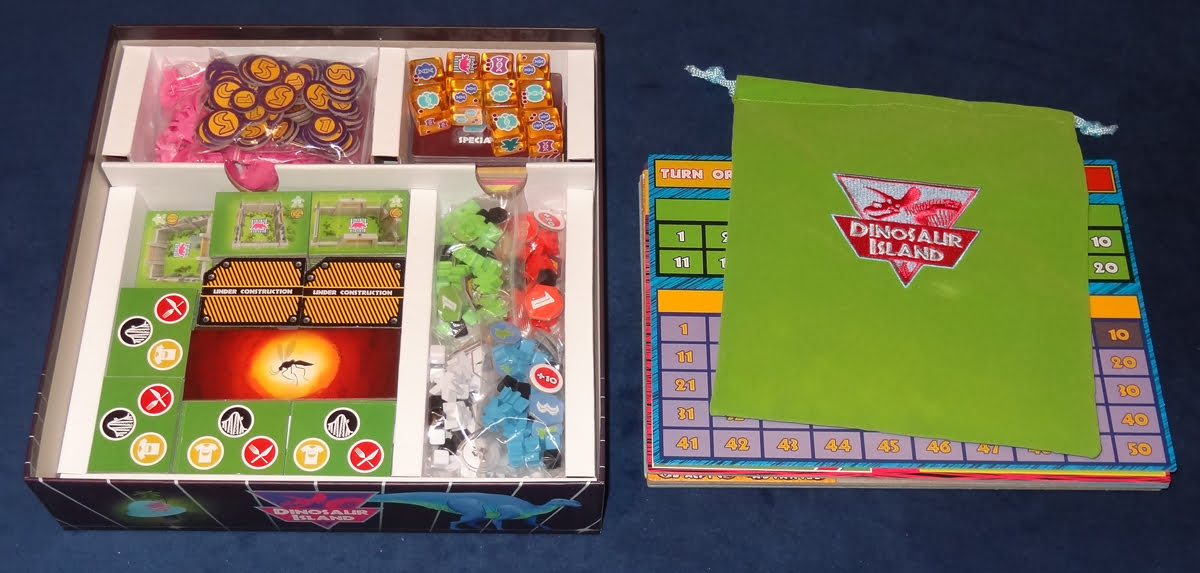
There are a lot of components, as you can see from the list and the photo. It’s all packed into a standard square box, but it can be a little bit of a puzzle getting everything to fit. The cardboard box insert isn’t great, though it is possible to make everything fit. (Unless you have the Kickstarter edition, in which case you have additional dinosaur meeples and metal coins, so good luck with that.)
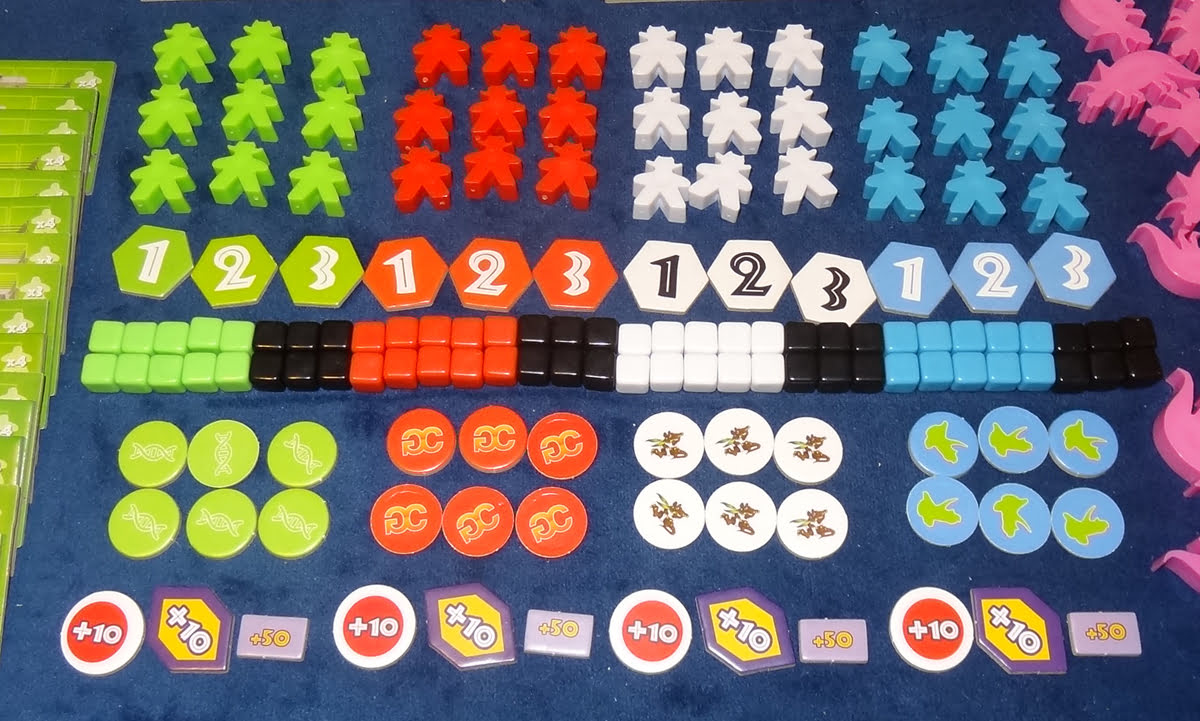
The retail edition, while it doesn’t have those fancy metal coins and the first player slap bracelet, is still nothing to sneeze at. The lab boards are dual-layered, so that there are inset holes for the marker cubes that keep them from sliding around.
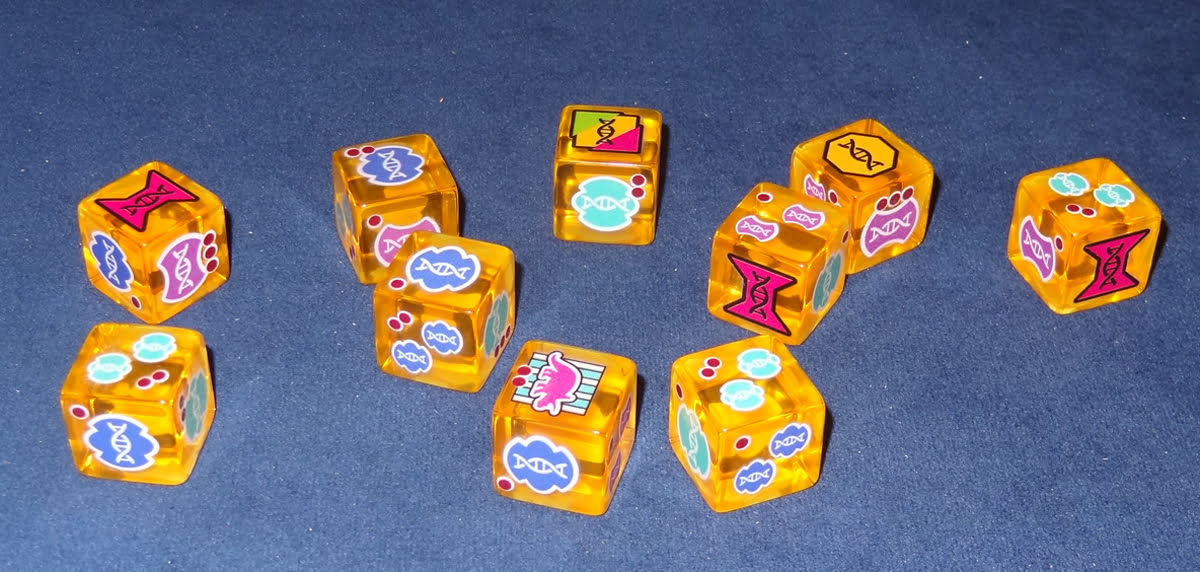
The dice are large and chunky, golden colored to look like blocks of amber, with screen-printed faces.
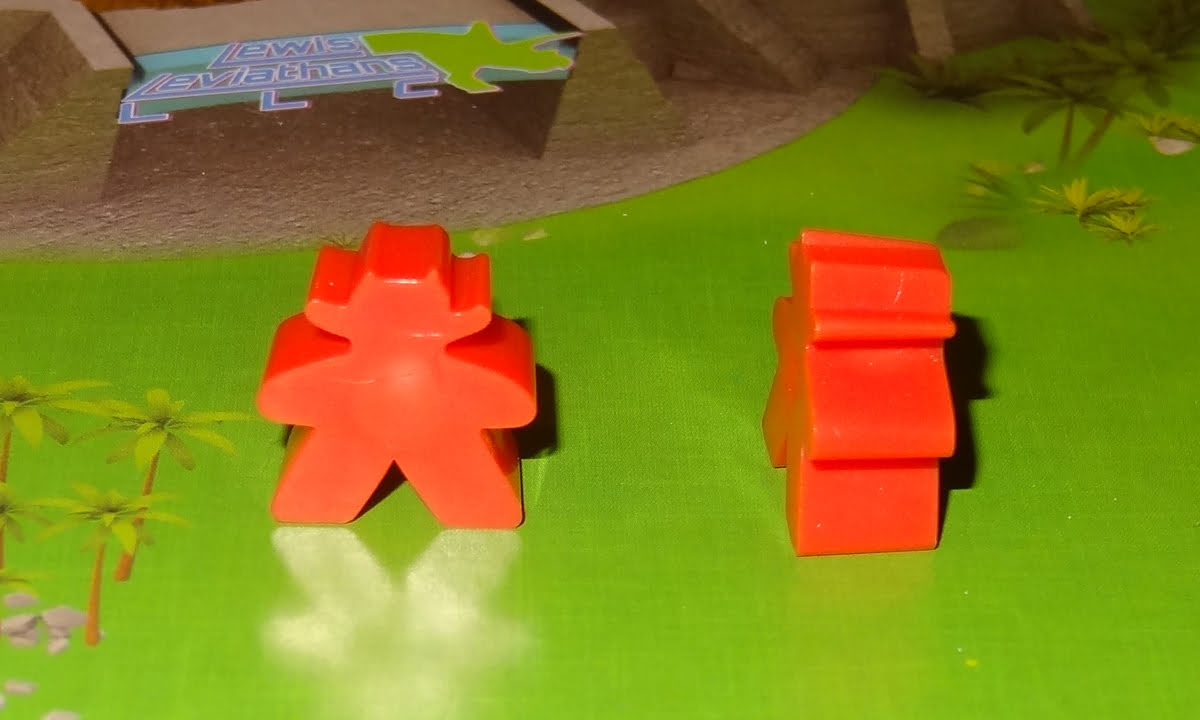
The meeples are all plastic—there’s actually no wood whatsoever in this game—and they’re bright and vivid. The only downside is that because they’re injection molded, they tend to have slight dimples and they’re a hair smaller on one face than the other, making them lean just ever so slightly. If you like stacking your meeples, that slope makes it just a little harder.

The aesthetic is in-your-face ’90s (paying tribute to the release date of the original Jurassic Park film), so you have bright pink dinos, a lime green cloth bag, and so on. Some people really dig the look, and some don’t—it’s admittedly a bit garish, but I like it.

The cloth bag itself is quite nice. It’s a heavy fabric with the logo embroidered on it, and it’s large enough that it’s quite easy to reach in and mix up the meeples inside. The visitor meeples—yellow patrons and purple hooligans—are also plastic, and are smaller than standard. For some reason the rulebook shows them as yellow and gold rather than yellow and purple, but I’m glad they aren’t actually that close in color.
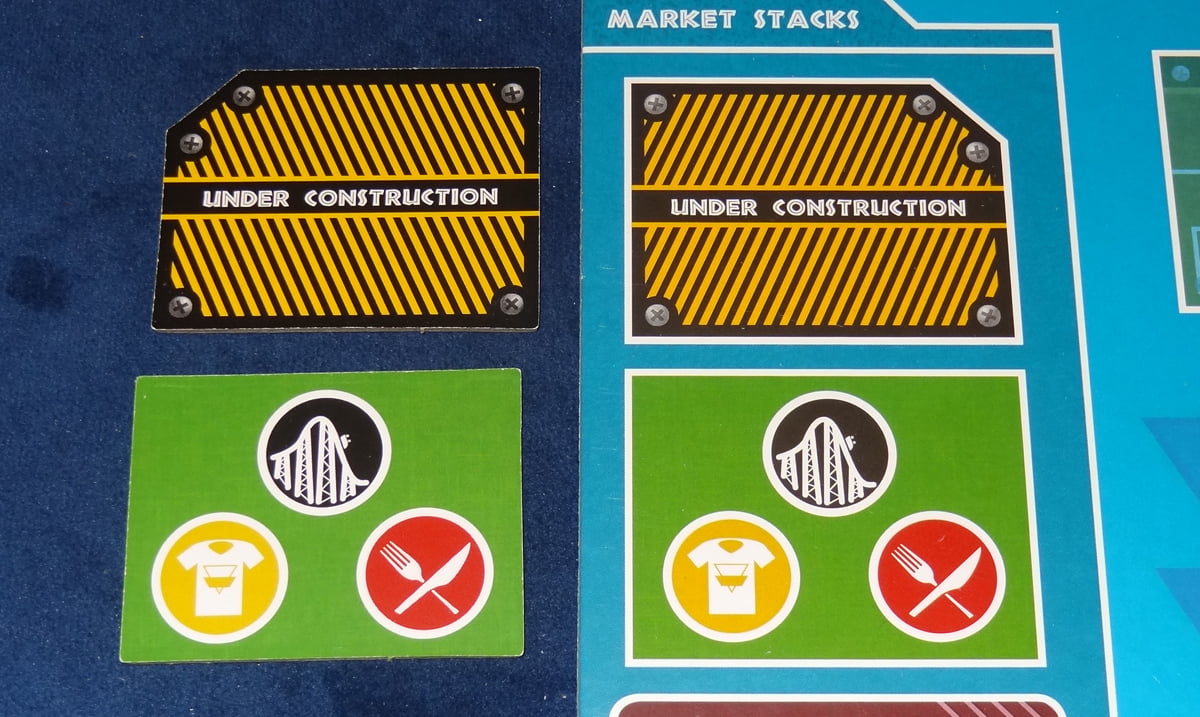
There are a few things here and there that bug me—like the fact that the space for the lab upgrades has the notched corner in reversed, or that the stacks of dinosaur recipes can make it hard to see which of the dice spaces has been claimed. The boards are clearly marked with the phase numbers, but not the names of the phases, which can be confusing when some of the specialist cards refer to phases by name instead of number. And the game is big: even at two players, you’ll find yourself using up a significant amount of table space. But overall, the component quality is very good, and the iconography is pretty well-done.
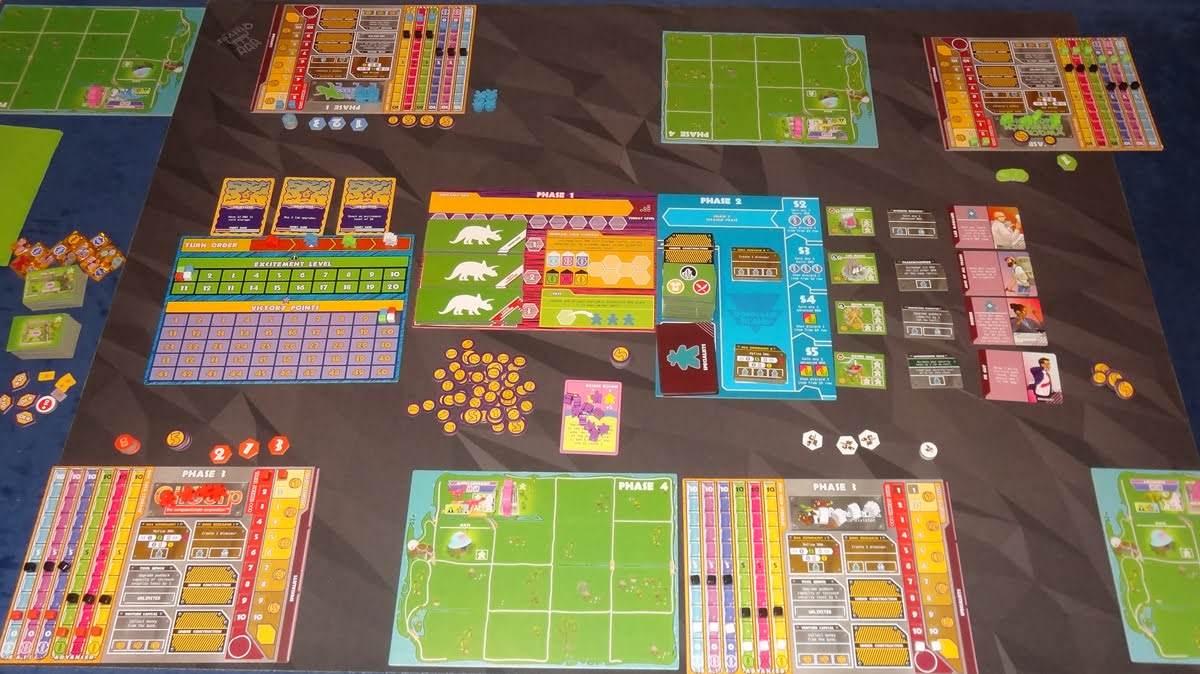
How to Play Dinosaur Island
You can download a copy of the rulebook here.
The Goal
The goal of the game is to score the most points by building attractions, creating dinosaurs, and, uh, not letting too many patrons get eaten.
Setup
Step 1: Get a bigger table. Okay, now that’s taken care of, you can spread out the boards and pieces.

In the center of the table, you’ll have:
- Tracker board, which tracks the turn order, each park’s excitement level, and each player’s victory points
- Research board, which holds the DNA dice and dinosaur recipes
- Market board, which holds the stacks of lab upgrades, attractions, and specialists
- Four rows of lab upgrades, attractions, and specialists to form the market
- Objective cards: one more than the number of players, chosen from short, medium, or long game
- 2 plot twist cards
- Other tokens and supplies: money, paddock tiles, dinosaur meeples, and the bag of visitor meeples
The first time you play, there are some recommended starting objectives and plot twists, but otherwise you can choose or deal randomly based on how long you want the game to be.
The number of dice used is 2x the number of players, plus 1 more. Take that number of dice from the pool and return the rest to the box. (Note that the dice are not all the same, so the random selection will affect which resources are generated during the game.)
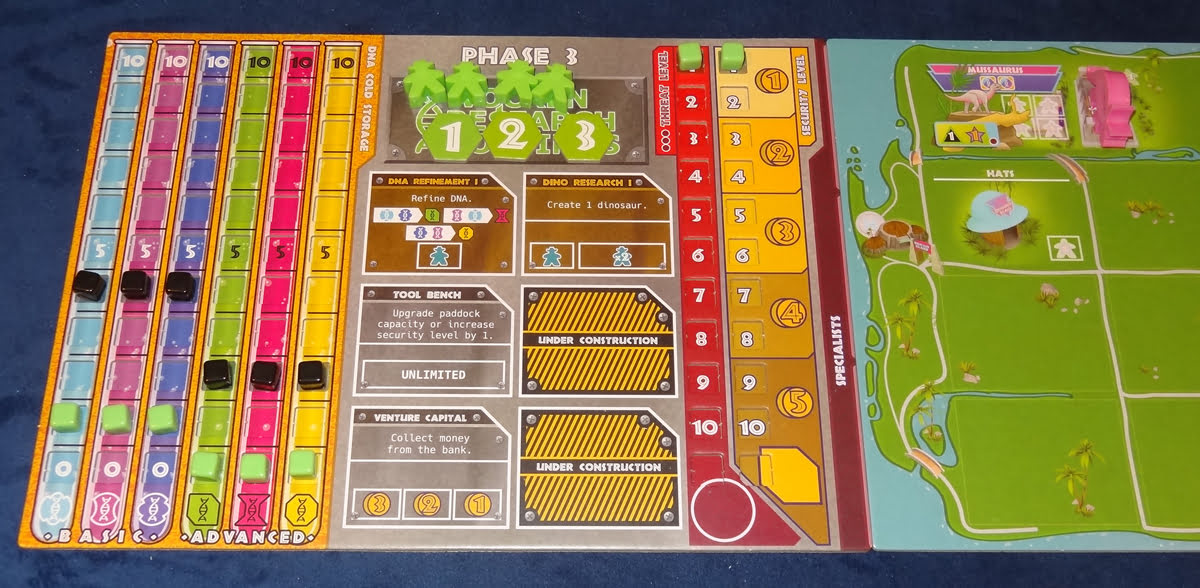
Each player will have a lab board and a park board, with space in between the two for a column of specialist cards. (Alas, the boards are laid out this way because the lab board is Phase 3 and the park board is Phase 4, but it means that the specialists go between the boards, rather than having the boards next to each other.) Put one dinosaur in the paddock on your park board.
On your lab board, you start with 1 of each of the basic DNA, and 0 of each of the advanced DNA. The black cubes mark your cold storage limits, which start at 4 for basic and 2 for advanced. You also use cubes to mark your starting threat level and security level (both at 1), and place cubes on the tracker board in the center to mark your current excitement level (1) and victory points (10—because you have to have something to lose if patrons get eaten).
Each person gets four of their worker meeples, set on their lab board’s logo, along with their three scientist tokens. The rest of the workers are set aside as a supply. Finally, everyone gets some starting cash—$15 for the first player, and $1 more for each successive player.
For the first round, you choose the starting player and then go clockwise for turn order, but in future rounds the turn order is based on score, and each phase will follow the turn order as marked on the tracker board.
Gameplay
Each round consists of five phases:
- Research
- Market
- Worker
- Park
- Cleanup

Research Phase
The first player rolls the DNA dice and places them on the research board. The top three dinosaur recipes (Herbivore, Small Carnivore, and Large Carnivore) should be turned face-up.
Starting with the first player, each player will assign one scientist per turn, until everyone has placed all three of their scientists. If you place your scientist in the space below a die, you take that type of DNA: multiply the value of your scientist with the value shown on the die and collect that much. Note that the black cubes limit how much DNA you can take on your board.
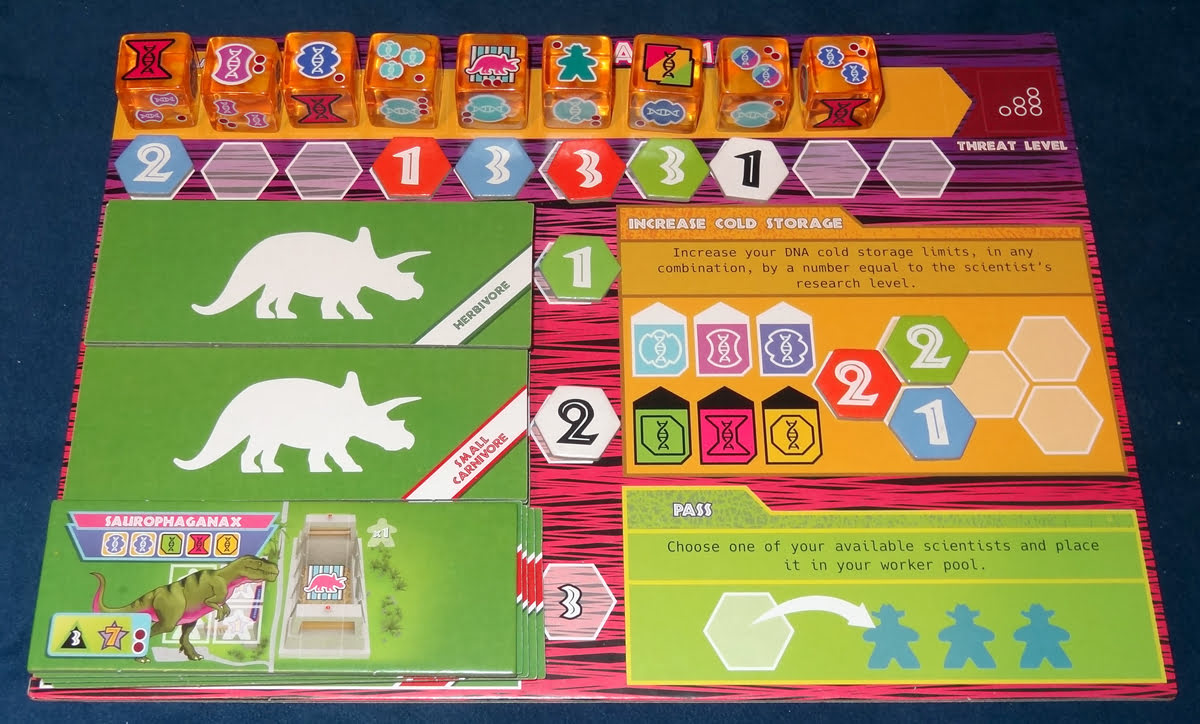
There are two special faces—the paddock allows you to increase your paddock size, and the worker lets you take an additional worker from your supply—but both faces require the “3” scientist to use.
You may also assign a scientist to increase your cold storage limits—the value of the scientist is the number of increases you get, which you can assign to any of the DNA types.
You can use a scientist to gain a dinosaur recipe: the number shown is the minimum level required to take that type of recipe, so any scientist can take an herbivore, but only the “3” scientist can take a large carnivore. Take the recipe tile and place it onto empty spaces in your park.
Finally, you can pass. Take your scientist and place it on your logo with your workers. That scientist will now count as an extra worker during Phase 3.

Once everyone has placed all three scientists (or passed), the research phase is over. The unclaimed die with the most red pips is placed on the “threat level” space to the right of the dice. This will be a temporary boost to the threat level during the park phase—take note!

Market Phase
The market area is where you get to buy things: lab upgrades, attractions, specialists, and even DNA (in case you didn’t get enough during the research phase). The market board holds the stacks of tiles, along with two special lab upgrades: Dino Research II and DNA Refinement II. (Note: for the starting setup, the first four attraction tiles are arranged in cost from lowest to highest, but in future rounds they will simply refill at the bottom.) The market phases includes two rounds of purchasing, so that each player will get two opportunities to buy something.
Each of the price tiers can be used to purchase DNA: $2 for 2 basic DNA, $3 for 3 basic DNA, $4 for 1 advanced DNA, and $5 for 2 advanced DNA. If you purchase DNA, you also discard one of the items in that price row to the right.
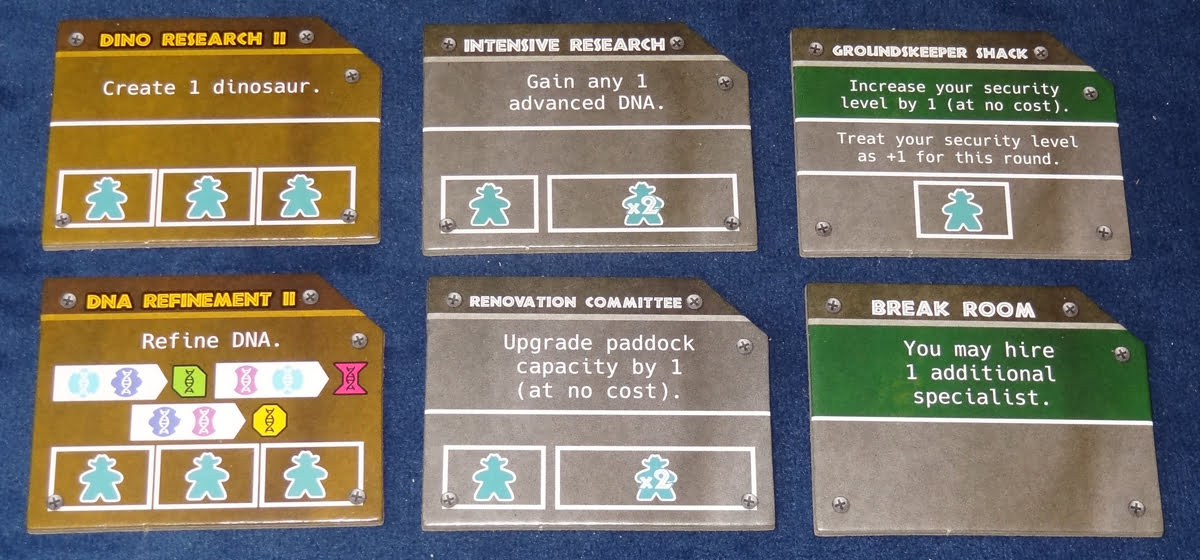
Lab upgrades go on your lab board, potentially covering up other lab upgrades if your board is full. The Dino Research II ($3) and DNA Refinement II ($5) may only be placed on top of the corresponding spaces on your board. Some upgrades have green banners—these are one-time immediate benefits when you build that lab upgrade. The cost of a lab upgrade is based on the row it is in, from $2 to $5.
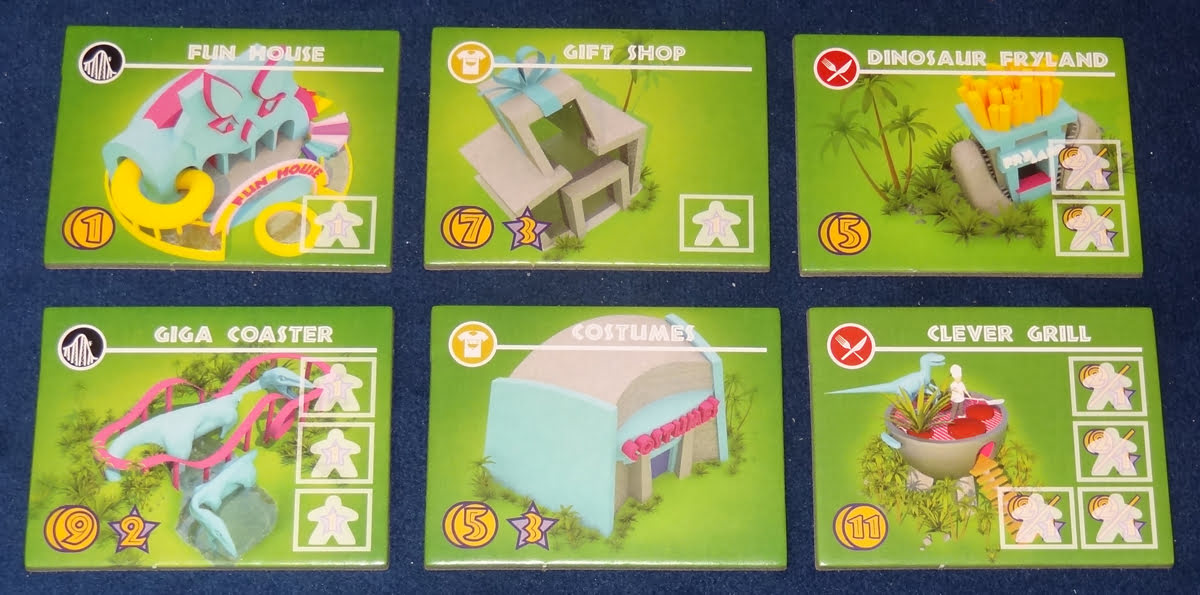
Attractions go onto your park board, and may provide spaces for visitors or points. There are three types: rides, merchandise, and food (including my favorite: Clever Grill). Food locations give you a choice between points or money when patrons are there, but rides and merchandise provide points only.
Note that attractions have a cost on them—the price to buy an attraction is this cost plus the value of the row you purchase it from.

Specialists are shown on cards, each with a title, artwork, and special ability. The cost to hire a specialist is based on its market row, and you place the card next to your lab board. You can hire up to 3 specialists, and after that you’ll have to fire (discard) a specialist before you can hire another one. If there is a worker meeple shown on the card, then you get to take a worker meeple from your supply and add it to your lab board—but if you ever fire that specialist, you lose the meeple as well.
After two rounds of purchasing, the market phase ends.

Worker Phase
During the worker phase, you’ll use your available workers (plus any scientists that you had set aside during the research phase), assigning them to various activities on your lab board. Your board starts with four available actions:
- DNA Refinement allows you to use a worker to combine 2 basic DNA into 1 advanced DNA (according to the recipes)
- Dino Research allows you to create dinosaurs by spending the necessary DNA; the first dino requires 1 worker, and the second requires 2 workers. Note that you must also have space in your paddock for the dinosaur.
- Tool Bench can take any number of workers. Each one can increase your paddock size by 1 or increase your security level by 1, both of which cost money as well.
- Venture Capital gets you some cold, hard cash. The first worker earns $3, second worker earns $2, and the third worker earns $1.
Lab upgrades you purchased during the market phase may give you additional abilities, but you must place the requisite workers on the spaces to use them. Each one is limited to the number of spaces shown, and unless otherwise specified, you still must pay the associated costs (e.g. in coins or DNA).
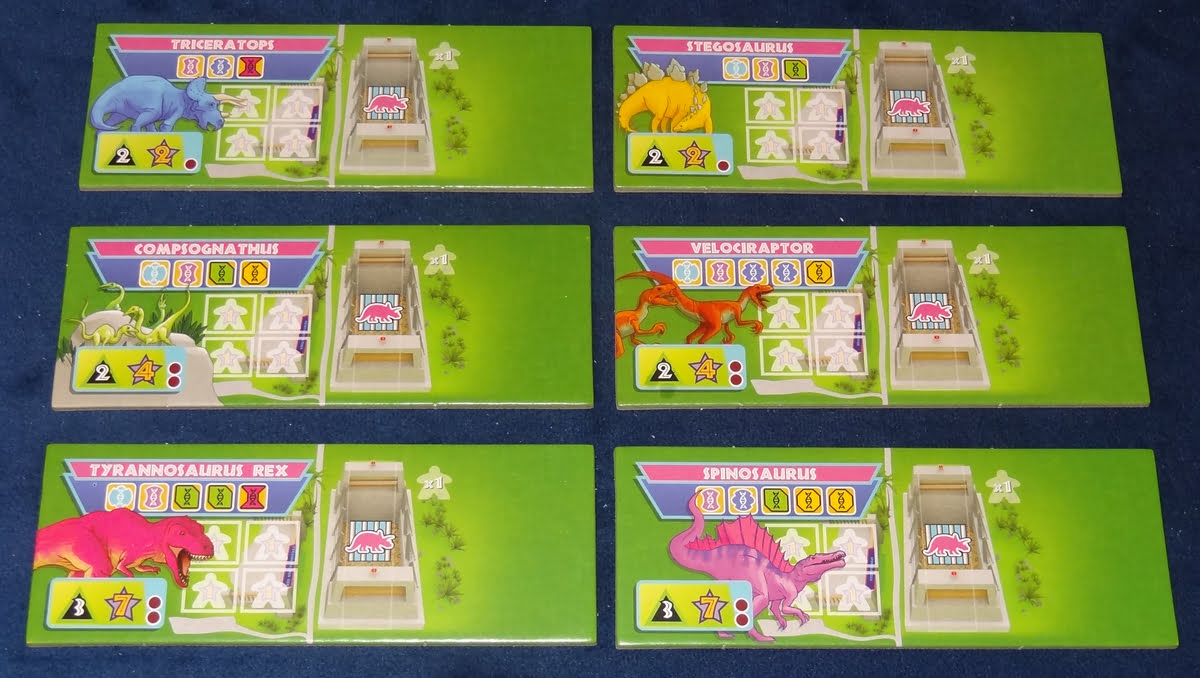
Each dinosaur recipe requires a certain mix of DNA per dino, and comes with a 1-dino paddock, which can be upgraded up to a 4-dino paddock. Herbivores require the least DNA to create, but also have lower excitement levels (to bring in visitors). Carnivores are more exciting and are also worth more points, but they also raise your park’s threat level more, which could end up in losing patrons.

When you create a dinosaur, place the dinomeeple in the corresponding paddock and then increase your excitement level and threat level per dinosaur as indicated on the dino recipe. The triangle is the excitement level, and the red dots are the threat level. The star indicates the victory point level per dinosaur of that type, but those points aren’t scored until the end of the game.
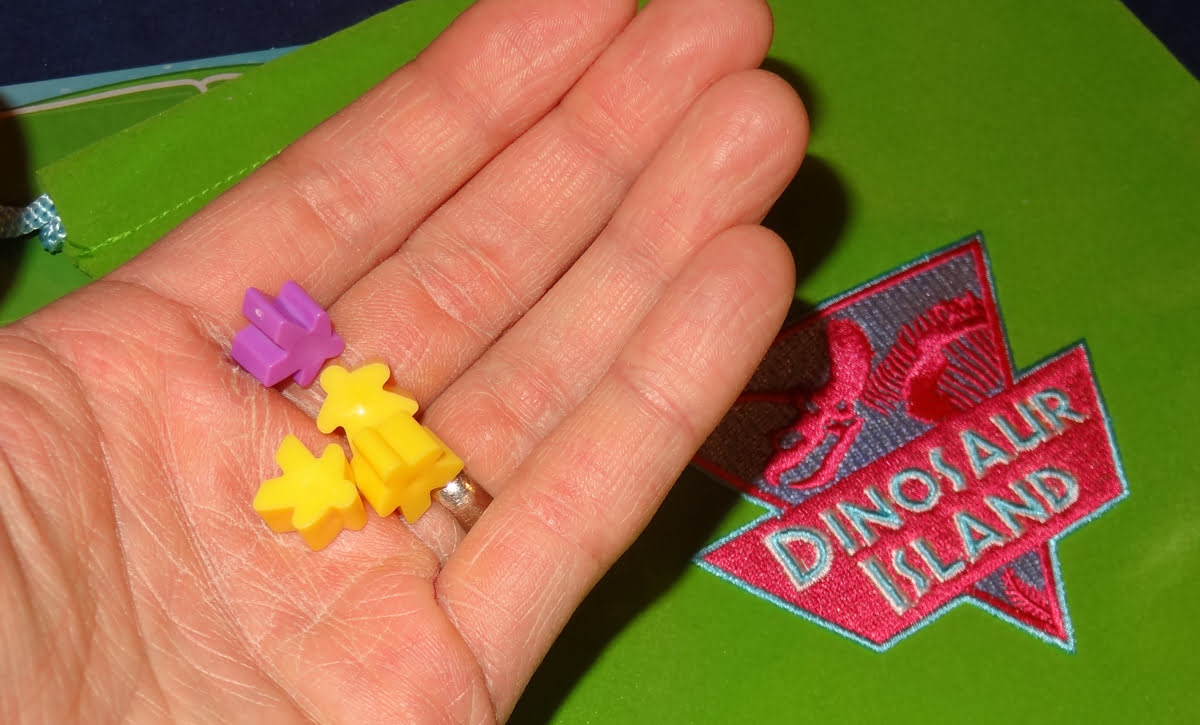
Park Phase
Finally, you’re ready to open the gates! During the park phase, visitors show up at your park, pay admission, and then–ahem–may or may not get eaten, depending on your security level.
Each player draws a number of visitors from the bag equal to their park’s excitement level. Purple meeples are hooligans: they hop over the turnstiles, jump the lines, and don’t even have the decency to let dinosaurs eat them first. Gold meeples are the paying patrons. You get $1 per patron, and nothing for the hooligans.
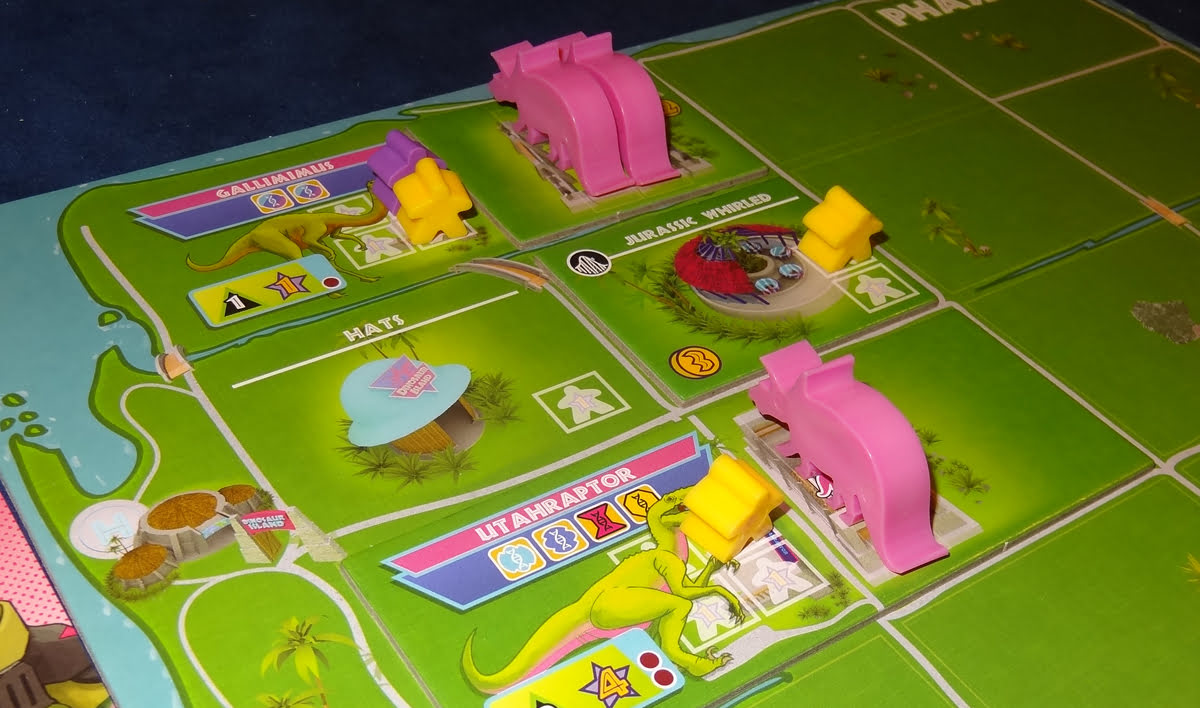
Then, you take all of your visitors and place them in your park on the available spaces. Each dinosaur exhibit can only hold as many visitors as there are dinosaurs (there are four spaces printed on the dino recipe, but you don’t get to use all of them at first), and attractions vary in the number of spaces. You must place hooligans first, and then patrons. Any visitors you have left over without spaces will be placed on the side of the board–they paid admission, but are standing in line and won’t score anything.
Then, you see who gets eaten. Look at your current threat level, and then add the temporary threat increase from the DNA die on the research board. If it’s higher than your security level, then you lose visitors equal to the difference. Patrons inside your park get eaten first, then patrons standing in line, and then finally the hooligans. You lose 1 point for each visitor that gets eaten.
Finally, for any patrons left in your park, you score points or earn money. Food attractions will earn you 1 point or $2 per patron, and all other spaces earn you 1 point per patron. (Hooligans don’t score you anything.)
Cleanup Phase
After everyone is done, you clean up for the next round. Gather up all visitors and put them back in the bag. Discard anything remaining in the $2 market row, slide everything up to fill in empty spaces, and then refill the four market rows.
Reveal the top dinosaur recipe of each type, and re-roll the DNA dice. Everyone takes back all of their scientists, and removes their workers from the spaces on their lab board, returning them to the logo space.
Finally, reset the turn order: the person with the lowest score becomes the first player, and the turn order track is rearranged. (For players who are tied for points, their relative order stays the same.)

Game End
The game end is triggered by the objective cards. Typically you will use one more objective card than the number of players. If you achieve an objective, you put one of your markers on it–but once somebody has claimed an objective, other players may only complete it in the same round. Once the round ends, that objective is locked in and nobody else can claim it, even if they achieve the conditions later.
When all but one of the objectives has been claimed, you finish the round and then the game ends.
Final scoring is as follows:
- Points for all of the attractions in your park that have star icons
- Points for each of your dinosaurs
- Points for objectives you completed
- 1 Point for every $5 left
The highest score wins, with ties going to the player with the most money left.
Solo Game
I have not yet had a chance to try the solo game, sorry! But if I try it out, I’ll add a more detailed explanation here.

Why You Should Play Dinosaur Island
The most obvious reason you should play Dinosaur Island is because you’re a fan of Jurassic Park and you’ve always wanted to try your own hand at making a theme park with dinosaurs and punny restaurants like “Jurassic Pork.” I mean, if that doesn’t appeal to you, then I’m not really sure why you’re even reading this.
But I should also note that, despite its bright colors and “10 and up” age recommendation, Dinosaur Island is a fairly hefty game. The decision to extract dinosaur DNA from ancient mosquitoes and bring velociraptors back to life should not be taken lightly–nor the choice to drop $85 or more on the Kickstarter campaign. That’s not to say that you can’t play it with a 10-year-old, but it would help if they already had some gaming experience to begin with. There’s worker placement, dice drafting, resource management, economics, risk management, and then some more worker placement.
It turns out that making dinosaurs is a complicated business. First, you need the dinosaur recipe. Then you need to get the right DNA. Then you need to make sure you have space in your paddock, which requires money–all of this taken care of from a limited pool of workers. If you finally do have all of those elements in place (and you have a worker left to create the dino), you might find that your security level isn’t high enough to handle the extra threat. The first time you play it, it can seem quite daunting just to get a dino on the board and keep it from eating up your visitors.
My other caveat, which I mentioned above, is that the visual aesthetic of the game isn’t for everyone. I’ve had a few players who felt it was too much and weren’t interested in playing, just based on the way it looks. If hot pink and lime green isn’t something you can bear to look at for an hour, then the gameplay may not matter.
But if you do like the way it looks and you’re up for some complexity, Dinosaur Island has a lot to offer.

One of the cool features is the adjustable game length. The number of objective cards is determined by the player count, but they also come in three types: short game, medium game, and long game. Some of the objectives are specific to a particular game length, but there are many (like those pictured above) that just ramp up for a longer game. So in a short game you may need to buy 3 lab upgrades for an objective, but you need 5 for a long game. The length of the game definitely affects the strategy; in a longer game, you may be able to risk letting some patrons get eaten in order to build up later, but in a shorter game those point losses can really hurt.
Regardless of the game length, Dinosaur Island has a lot going on. I like the flow of the game, figuring out all the logistics involved in making more dinosaurs. The dice-drafting has importance not just for collecting DNA, but also because it will affect the threat level. That can force decisions about whether to get more (or better) DNA, or try to claim the dice with the higher threat levels (which then helps keeps everyone safer).
How much money (and workers) do you invest in security? Do you increase your paddock so you can make more dinosaurs, raising your excitement level to bring in more paying patrons? Or do you hire the specialist that lets you boot hooligans out of your park, giving you a better chance to earn more money for admission? If you increase your park’s excitement levels but you don’t buy some more attractions, chances are you won’t have space for all of those patrons who show up–and that’s lost points we’re talking about. The game has a lot of decisions to make on how you spend your actions and your resources, and I’m excited about trying out different approaches. The downside, of course, is that if you’re the sort of player who suffers from analysis paralysis, you’ll be facing a gauntlet of tough decisions throughout each phase of the game.
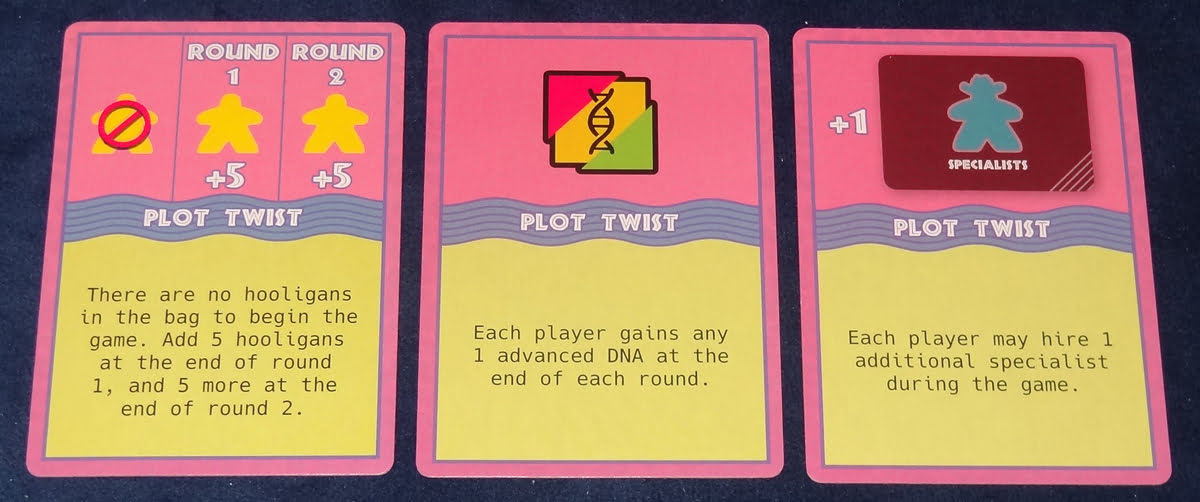
A great feature that adds replayability is the plot twists. Generally you’ll use two of these per game, and they’re a global change that affects everyone. For the first game, you just use the plot twist about hooligans: you start with none in the bag, and add 5 for the second round and the other 5 for the third round. It helps you get used to the flow of the game without having to worry about lost income quite as much as you get going. Other plot twists may let you hire more specialists (or restrict you to 1 for the whole game!), or clear more rows of the market, and so on. My only gripe about the plot twists is that I think they should have unique names, rather than just “Plot Twist.” Again, I’ve only scratched the surface with these so far, and I think the game has a pretty solid core even without them, but I like the way that these mix up the feel of the game each time.
The game’s price may be a barrier for many: $85, even with those deluxe components, is a lot to spend on a single game. (For comparison, I spent $80 on my non-deluxe edition.) You are getting a lot of quality components and that box is filled to the top, but components alone aren’t enough to justify spending money on a game if you don’t play it. For me, I think it’s the combination that makes it worth it for me: the number and quality of the components, the wild color scheme, the pink plastic dinosaurs, the sprawling gameplay, and the terrific theme. All of those add up to a really fun experience, and I’m looking forward to building (and rebuilding) my dinosaur theme parks again and again.

I don’t play as many 2-player-only games, so I haven’t really paid as much attention to Duelosaur Island myself, though I do like the dice-drafting mechanic they describe. Totally Liquid adds aquatic dinosaurs, plus blueprints that will award points for following a particular layout for your park, and park extensions with new ways to score points and use your workers. And even without all those new mechanics, it also adds a 5th player to the game (though I expect you may need to find an even bigger table to fit everything!).
There’s just about a week left on the Kickstarter campaign now, so if your interest has been piqued, don’t wait too long. For more information or to make a pledge, visit the Dinosaur Island Kickstarter page!
Click here to see all our tabletop game reviews.
If you’d like to stay up-to-date with all of our tabletop gaming coverage, please copy this link and add it to your RSS reader.
Disclosure: GeekDad received a copy of this game for review purposes.
